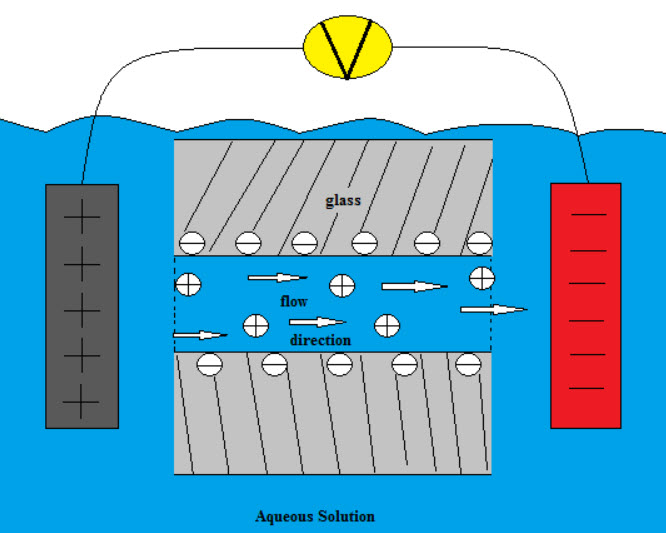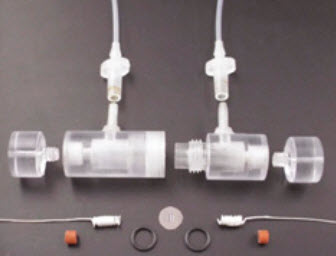Diagnostic devices the size of a credit card
Shrinking laboratory-scale processes to automated chip-sized systems would revolutionize biotechnology and medicine
October 29, 2013
[+]
A silicon nanomembrane developed at the University of Rochester could drastically shrink the power source needed with electroosmotic pumps
(EOPs) to move solutions through micro-channels — paving the way for
ultra-thin ”lab-on-a-chip” diagnostic devices the size of a credit card.
Concept
for a microfluidic bioreactor: two chambers separated by a nanoporous
silicon membrane (credit: Adam Fenster/University of Rochester)
“Until now, electroosmotic pumps have had to operate at a very high voltage — about 10 kilovolts,” said James McGrath, associate professor of biomedical engineering.
“Our device works in the range of one-quarter of a volt, which means it can be integrated into devices and powered with small batteries.”
[+]
McGrath and his team use 15-nm-thick porous nanocrystalline silicon
(pnc-Si) membranes — 1,000 of these stacked equal the width of a human
hair.
Electroosmotic
pumps use a porous membrane between two electrodes to create an
electroosmotic flow, which occurs when an electric field interacts with
ions on a charged surface, causing fluids to move through channels
(credit: Wikimedia Commons)
[+]
The thin pnc-Si membranes allow the electrodes to be placed much
closer to each other, creating a much stronger electric field with a
much smaller drop in voltage, thus allowing for a smaller power source.
A prototype EOP pump (credit: Jessica L. Snyder et al./PNAS)
Applications
The nanocrystalline silicon membranes are inexpensive to make and can be easily integrated on silicon or silica-based microfluidic chips, said McGrath.
Besides portable medical diagnostic devices, inexpensive, highly portable devices that process blood samples to detect biological agents such as anthrax are also needed for military and homeland-security efforts.
EOPs could also be used to cool electronic devices, such as laptops and other portable electronic devices.
Abstract of PNAS paper
We have developed electroosmotic pumps (EOPs) fabricated from
15-nm-thick porous nanocrystalline silicon (pnc-Si) membranes. Ultrathin
pnc-Si membranes enable high electroosmotic flow per unit voltage. We
demonstrate that electroosmosis theory compares well with the observed
pnc-Si flow rates. We attribute the high flow rates to high electrical
fields present across the 15-nm span of the membrane. Surface
modifications, such as plasma oxidation or silanization, can influence
the electroosmotic flow rates through pnc-Si membranes by alteration of
the zeta potential of the material. A prototype EOP that uses pnc-Si
membranes and Ag/AgCl electrodes was shown to pump microliter per
minute-range flow through a 0.5-mm-diameter capillary tubing with as low
as 250 mV of applied voltage. This silicon-based platform enables
straightforward integration of low-voltage, on-chip EOPs into portable
microfluidic devices with low back pressures.
(¯`*• Global Source and/or more resources at http://goo.gl/zvSV7 │ www.Future-Observatory.blogspot.com and on LinkeIn Group's "Becoming Aware of the Futures" at http://goo.gl/8qKBbK │ @SciCzar │ Point of Contact: www.linkedin.com/in/AndresAgostini
 Washington
Washington